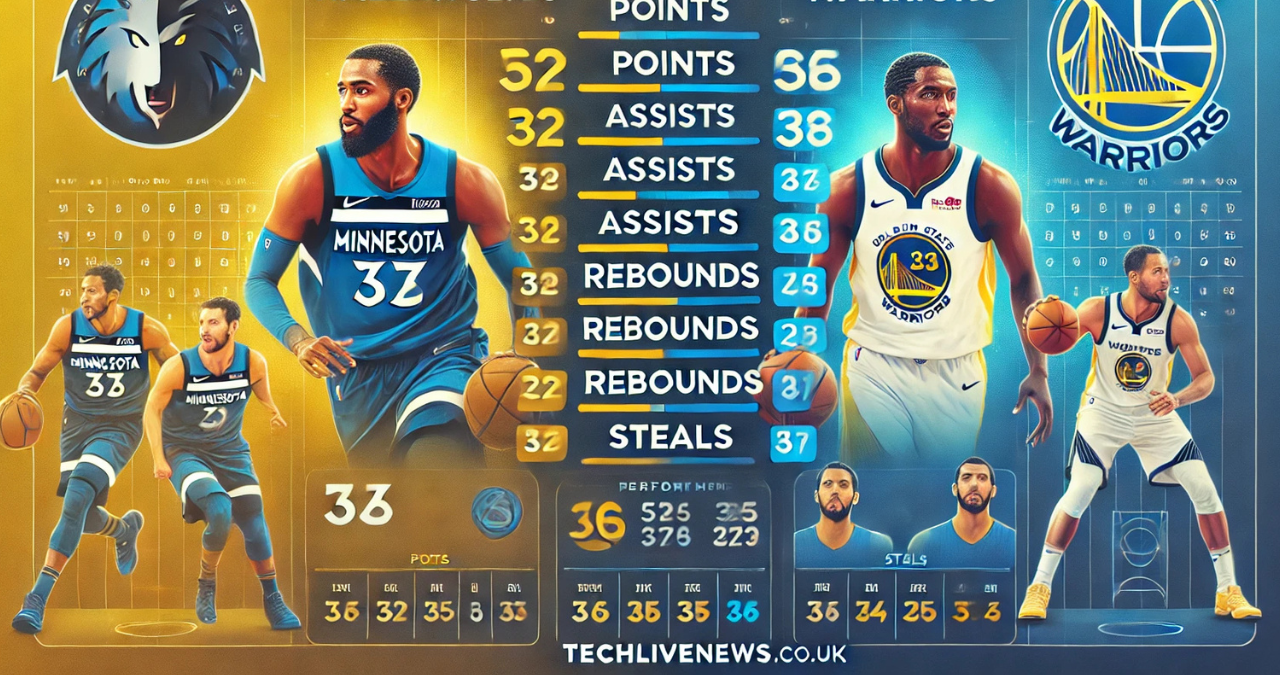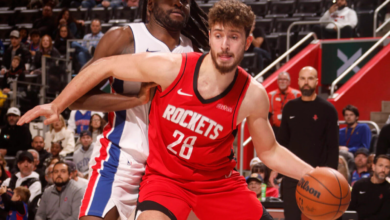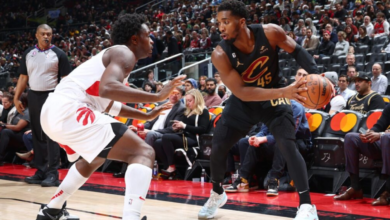Introduction
The NBA continues to captivate basketball enthusiasts worldwide with its thrilling matchups, and the Timberwolves vs. Golden State Warriors game was no exception. These two teams, both renowned for their unique styles of play and passionate fanbases, delivered a nail-biting contest that kept viewers on the edge of their seats.
Player stats are more than just numbers; they reveal the strategies, strengths, and weaknesses of each team. They provide insights into how games are won and lost, and which players made the most significant impact. This article explores the player statistics from this electrifying matchup, offering an in-depth analysis of individual performances and team dynamics.
Whether you’re a Timberwolves fan eager to celebrate your team’s standout moments or a Warriors supporter analyzing the competition, this breakdown will provide you with valuable insights into the game’s pivotal moments and key contributors.
Team Performance Overview
Game Summary
The Timberwolves and Warriors clashed in a game that highlighted the best of NBA basketball. From precise shooting to gritty defense, both teams showcased their talents in an exhilarating contest. The final score was a tight battle, with the Warriors edging out a narrow victory at 112-110.
Key moments included a stunning third-quarter rally by the Warriors, fueled by their three-point shooting prowess. The Timberwolves, however, fought valiantly, with their defense leading to crucial turnovers in the fourth quarter. Despite their efforts, they couldn’t overcome the Warriors’ consistent scoring and efficient ball movement.
The statistical comparison revealed a slight edge for the Warriors in shooting accuracy, particularly from beyond the arc. The Timberwolves, on the other hand, dominated the paint with more points from close range and second-chance opportunities.
Team Strengths and Weaknesses

The Timberwolves leaned heavily on their interior scoring and rebounding capabilities. Karl-Anthony Towns was instrumental in controlling the paint, while Anthony Edwards’ athleticism kept the defense guessing. However, their perimeter shooting left much to be desired, as they struggled to convert three-point opportunities consistently.
The Warriors’ hallmark three-point shooting was their standout strength. Led by the sharpshooting duo of Stephen Curry and Klay Thompson, they capitalized on every defensive lapse by the Timberwolves. However, the Warriors showed vulnerability in their interior defense, conceding significant points in the paint.
Individual Player Statistics
Star Performers
Stephen Curry once again demonstrated why he’s considered one of the greatest players of all time. He finished the game with 34 points, 8 assists, and 6 rebounds, including six three-pointers that came at critical junctures. Curry’s ability to create space and score under pressure was the difference-maker.
For the Timberwolves, Anthony Edwards shone brightly. He tallied 28 points, 7 rebounds, and 4 assists, showcasing his versatility on both ends of the floor. Edwards’ athletic drives to the basket and mid-range jumpers kept the Timberwolves competitive throughout the game.
Role Players’ Contributions
Draymond Green’s impact often goes beyond the box score, but his 10 rebounds, 7 assists, and relentless defense were pivotal. His ability to facilitate the Warriors’ offense while anchoring their defense made him indispensable. Andrew Wiggins chipped in with 18 points, proving his consistency as a secondary scorer.
On the Timberwolves’ side, Rudy Gobert controlled the glass with 14 rebounds and added 10 points, solidifying his presence as a dominant big man. Jaden McDaniels’ defensive tenacity was notable, as he disrupted the Warriors’ rhythm with key stops and blocks.
Head-to-Head Matchups
The duel between Anthony Edwards and Andrew Wiggins was a highlight of the game. Edwards had the upper hand offensively, but Wiggins’ defense played a crucial role in limiting Edwards’ effectiveness in critical moments.
In the battle of the big men, Karl-Anthony Towns and Draymond Green exchanged blows. While Towns dominated the scoring, Green’s playmaking and defensive positioning proved vital for the Warriors’ success.
Key Statistical Insights
Shooting Efficiency
The Warriors’ shooting efficiency was the standout factor in their victory. They shot 45% from the field and an impressive 38% from beyond the arc. Curry and Thompson’s shooting combined for a significant portion of this success. In contrast, the Timberwolves managed 42% from the field and only 31% from three-point range, which ultimately hurt their chances.
Rebounding Battle
The Timberwolves dominated the boards with 52 total rebounds compared to the Warriors’ 44. Gobert and Towns were instrumental in securing offensive rebounds, leading to second-chance points that kept the game close. However, the Warriors’ ability to box out and secure defensive rebounds during crucial possessions balanced this advantage.
Playmaking and Turnovers
The Warriors excelled in playmaking with 26 assists compared to the Timberwolves’ 20. Green’s vision and Curry’s off-ball movement created open looks for their teammates. Turnovers, however, were nearly identical, with both teams committing 14, highlighting the evenly matched nature of the contest.
Defensive Impact
Blocks and steals were critical in this game. The Timberwolves recorded 8 blocks, with McDaniels contributing 3, showcasing their defensive intensity. The Warriors, on the other hand, forced 10 steals, with Gary Payton II leading the charge. Their ability to convert these turnovers into fast-break points gave them a slight edge.
Lessons and Takeaways
The Timberwolves demonstrated their potential to compete against elite teams but need to improve their perimeter shooting and defensive consistency. Their ability to dominate the paint is commendable, but a balanced offensive attack will be crucial for future success.
The Warriors reinforced their reputation as a three-point juggernaut but must address their vulnerability in the paint. Their ability to adapt and leverage their strengths is a testament to their championship pedigree, but consistency in rebounding will be key in tougher matchups.
Conclusion
The Timberwolves vs. Warriors game was a masterclass in basketball strategy and execution. Both teams showcased their strengths and exposed areas for improvement, making this matchup a fascinating case study for fans and analysts alike.
Player stats revealed the story behind the scoreboard, highlighting individual brilliance and team dynamics. Whether it’s Curry’s unparalleled scoring ability or Edwards’ relentless drives, the game was a testament to the talent and passion in the NBA.
As the season progresses, these insights will prove valuable in understanding how both teams can refine their gameplay and strive for success.
FAQs
1 What were the key statistics from the Timberwolves vs. Golden State Warriors match?
The Warriors shot 45% from the field and 38% from three, while the Timberwolves dominated rebounds with 52 boards.
2 Who were the standout performers in the game?
Stephen Curry (34 points) and Anthony Edwards (28 points) were the standout performers for their respective teams.
3 How do these stats compare to the season averages of the teams?
The Warriors’ three-point shooting was slightly above their season average, while the Timberwolves exceeded their usual rebounding metrics.
4 What was the biggest factor contributing to the final score?
The Warriors’ superior shooting efficiency, particularly from three-point range, was the decisive factor.
5 How did the bench players perform in this game?
The Warriors’ bench contributed timely points and defensive stops, while the Timberwolves relied heavily on their starters for scoring.
You May Also Read:https://techlivenews.co.uk/washington-wizards-vs-houston-rockets-match-player-stats/




